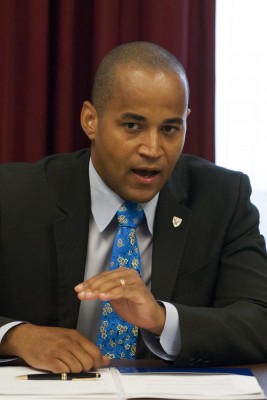
Business Council for American Security President and CEO of Risk Cooperative Dante Disparte on Understanding Social Risk Insurance
Business Council for American Security President and CEO of Risk Cooperative Dante Disparte together with James Sisco wrote the following article which was also published online at Risk Management Magazine.
Traditional insurance coverage acts as a passive mechanism to protect against an unlikely but extreme financial loss. Particularly in emerging markets where historical loss information is limited, insurance underwriting requires multinational corporations to view risk through a different lens.
Models that incorporate qualitative factors such as social risk—threats that emanate from individuals, communities, activist networks and extremist groups in the form of litigation, protests, strikes and violence—allow companies to use insurance as a mechanism to improve investment decisions and operations. But enhancing the insurance process from being a line item cost to acting as a catalyst for investment and operational decision-making requires insurance underwriters, risk managers and other stakeholders to understand the drivers of social risk.
The Problem with Overlooking Qualitative Factors
Current political risk underwriting methods assign limited value to qualitative variables. The result is an overdependence on outdated quantitative risk models that rely solely on historical events. Compounding these challenges, underwriters often put a premium on “hard” security measures, such as physical and psychological barriers separating the firm’s operations from the population, which can actually increase conflict with the community. This not only misprices risk, but often dries up critical underwriting support except for a reserve of blue-chip brand names and projects.
During the peak of conflict in Iraq and Afghanistan, for example, many forms of insurance were available, if not required outright by government contracts. However, underwriting requirements called for customers to operate in high-profile armored convoys, reside in fortress-like compounds and, in some cases, be accompanied by armed guards. Doing so had the pernicious effect of creating targets while alienating the local population. This posture often created a placebo effect, making security and risk management seem adequate. It was only later in the conflict that security firms adopted a softer approach, opting for low-profile, soft-bodied vehicles, breaking convoys into smaller groups and donning unassuming attire. Following a series of high-profile financial losses, insurers began supporting this approach, particularly for kidnap and ransom coverage.
The Need to Better Understand Social Risk
Most multinational corporations employ an expensive set of passive tools and measures to protect against the juridical, property and financial exposures of their asset base worldwide. Even with these packages, firms maintain financial liquidity to buttress against often uninsurable or unforeseen risks, including data security and regulatory changes. Of particular interest to managers, boards and shareholders is political risk insurance, which is not a standardized class of insurance and cannot cover every contingency.
Companies now operate within dynamic, complex social environments instead of clearly defined nation-states, often without consent from citizens. To effectively operate in these environments, they must broaden their risk strategies to evolve in sync with the changes in society. This includes integrating social risk analysis to properly insure assets and protect people.
While social risk is not a new issue, it is increasing as globalization and new communication technologies connect diverse individuals and communities. While most companies attempt to mitigate technical, economic, reputational and environmental risk, it is social risk that fuels these contemporary exposures. Social risk is a relatively new concept, however, and it is often ambiguous, ill-defined, and mistaken for geopolitical risk. Unlike most contemporary risks that focus on a specific topic or interest, social risk has broad implications and the potential to impact investments up and down the supply chain, with varying degrees of severity.
The role of social risk analysis is to enhance stability and security by concentrating on individuals and communities. Recognizing social risk factors enables companies to prevent groups from adversely affecting, disrupting or stopping operations through litigation, strikes, protests, sabotage and violence. Social risk analysis addresses such influences on a company’s operations and insurance policies in order to protect company investments and personnel.
Matching Insurance to the Project Lifecycle
What customers need is proactive insurance that does not simply provide a payout, but also protects and mitigates risk from the outset of the underwriting process. By injecting a consistent population-centric methodology that analyzes social risk as a qualitative factor, underwriters can improve their intelligence and judgment about which projects to include in their portfolio. This analysis will reduce expensive recovery costs, more accurately spread the risk across types of projects, provide a forward-looking tool for judgment, and help underwriters bridge the gap between perceived and actual risk. For insurance buyers, getting more intelligence and identifying risk factors early in the project lifecycle will improve stakeholder engagement and reduce the risk of expropriation and violence.
A population-centric methodology identifies key challenges, opportunities and specific complexities within communities where the customer is operating. The process uncovers the sentiments and narratives that resonate across the greatest segments of a given population. The result is a better understanding of underlying social tensions, providing the opportunity to pinpoint and mitigate the systemic drivers of instability or unrest.
Once these drivers are identified, they can be systematically quantified and incorporated into the underwriting process. This broadens the classes of insurance that can be leveraged to mitigate the risk of a particular project. It also identifies exposures in an operation that are uninsurable, but readily mitigated.
After an initial insurance package is executed, multinational corporations will have the opportunity to address uninsurable risk factors by incorporating a strategy that better engages the specific population into their operations. By identifying these risk factors during the underwriting process, firms can construct and apply unique engagement strategies to communicate and coexist with the communities where they operate.
As a result, buyers can access an entire network to identify and mitigate risk rather than just hold the typical yearly meeting to sign insurance documentation for protection against extreme downside loss.





